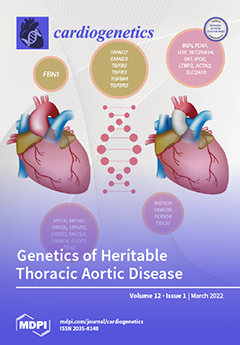Open AccessCase Report
Diagnosis of Fabry Disease in a Patient with a Surgically Repaired Congenital Heart Defect: When Clinical History and Genetics Make the Difference
by
Marta Rubino, Emanuele Monda, Martina Caiazza, Giuseppe Palmiero, Michele Lioncino, Annapaola Cirillo, Adelaide Fusco, Federica Verrillo, Alessia Perna, Gaetano Diana, Federica Amodio, Arturo Cesaro, Giovanni Duro, Berardo Sarubbi, Maria Giovanna Russo, Paolo Calabrò and Giuseppe Limongelli
Cited by 1 | Viewed by 3828
Abstract
Fabry disease (FD) is a multiorgan disease, which can potentially affect any organ or tissue, with the heart, kidneys, and central nervous system representing the major disease targets. FD can be suspected based on the presence of specific red flags, and the subsequent
[...] Read more.
Fabry disease (FD) is a multiorgan disease, which can potentially affect any organ or tissue, with the heart, kidneys, and central nervous system representing the major disease targets. FD can be suspected based on the presence of specific red flags, and the subsequent evaluation of the α-Gal A activity and GLA sequencing, are required to confirm the diagnosis, to evaluate the presence of amenable GLA mutation, and to perform a cascade program screening in family members. An early diagnosis is required to start an etiological treatment and to prevent irreversible organ damage. Here, we describe a case of a 37-years-old patient, with a surgically repaired congenital heart defect in his childhood, who had a late diagnosis of FD based on the clinical history and targeted genetic evaluation. This case highlights the importance to perform a correct phenotyping and definite diagnosis of FD, to start an early and appropriate treatment in the index patient, and a cascade clinical and genetic screening to identify other family members at risk, which may benefit from specific treatment and/or a close follow-up.
Full article
►▼
Show Figures





